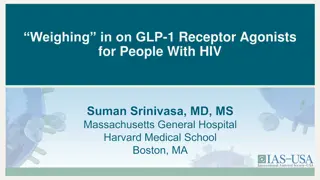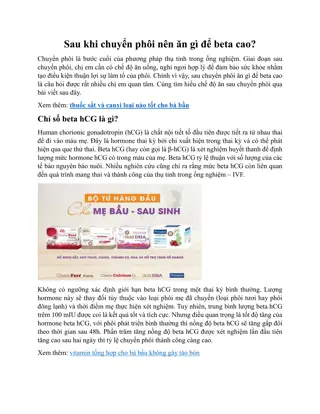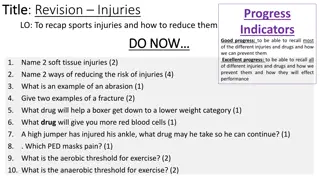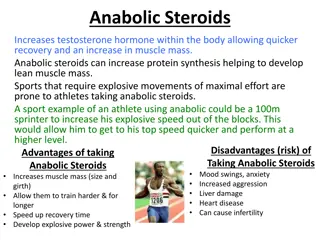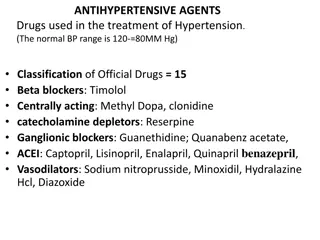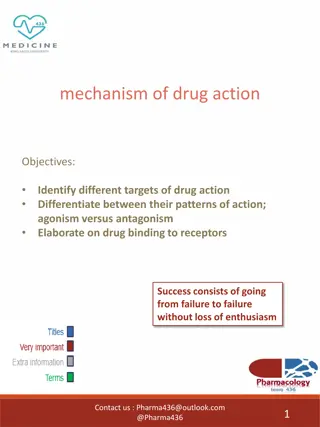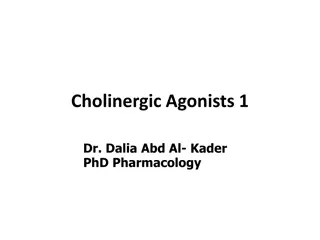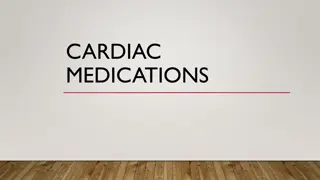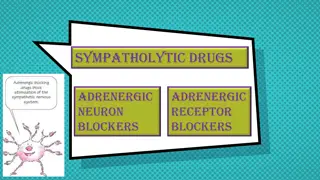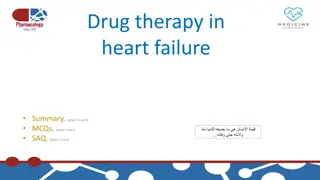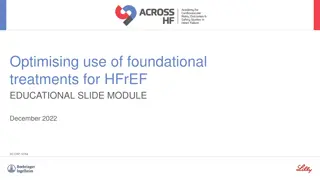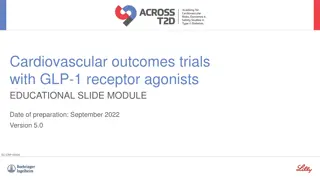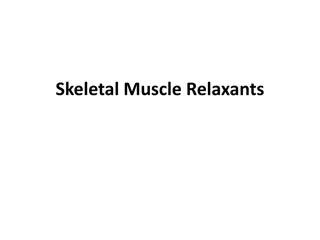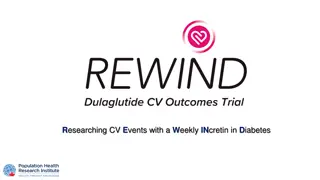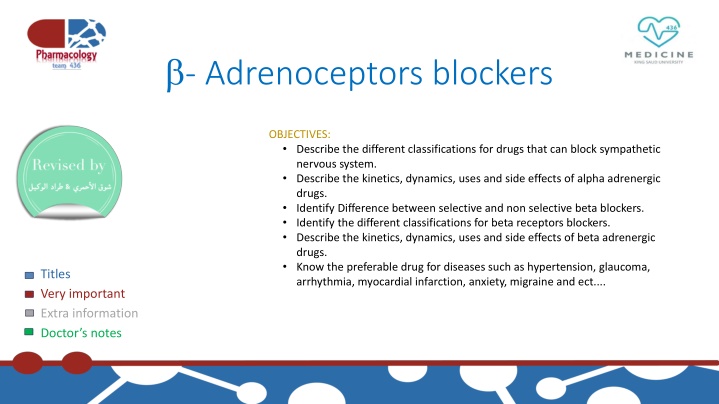
Adrenoceptors Blockers and Their Classification
Learn about the classifications of drugs that block the sympathetic nervous system, the kinetics, dynamics, uses, and side effects of alpha and beta adrenergic drugs, differences between selective and non-selective beta blockers, and the suitable drugs for various conditions like hypertension, glaucoma, and more.
Download Presentation

Please find below an Image/Link to download the presentation.
The content on the website is provided AS IS for your information and personal use only. It may not be sold, licensed, or shared on other websites without obtaining consent from the author. If you encounter any issues during the download, it is possible that the publisher has removed the file from their server.
You are allowed to download the files provided on this website for personal or commercial use, subject to the condition that they are used lawfully. All files are the property of their respective owners.
The content on the website is provided AS IS for your information and personal use only. It may not be sold, licensed, or shared on other websites without obtaining consent from the author.
E N D
Presentation Transcript
- Adrenoceptors blockers OBJECTIVES: Describe the different classifications for drugs that can block sympathetic nervous system. Describe the kinetics, dynamics, uses and side effects of alpha adrenergic drugs. Identify Difference between selective and non selective beta blockers. Identify the different classifications for beta receptors blockers. Describe the kinetics, dynamics, uses and side effects of beta adrenergic drugs. Know the preferable drug for diseases such as hypertension, glaucoma, arrhythmia, myocardial infarction, anxiety, migraine and ect.... Titles Very important Extra information Doctor s notes
Adrenergic receptors Beta 1 Beta 2 Beta 3 Site Heart Adipose tissue Smooth muscle Relaxation of smooth muscles. Hyperglycemia due to: o Release of glucagon from pancreas. Increase heart Rate (Positive chronotropic effect). Increase in contractility Action Lipolysis. (Positive inotropic action). Increase in conduction velocity (Positive dromotropic). o Glycogenolysis & gluconeogenesis in liver (With 1) 2
Classification of - Adrenoceptors Blockers According to the According to the selectivity selectivity many side effect T Timolol S Sotalol P Propranolol non selective (TSP) so selective drugs (At ten =Aten) Did you meto elly Esmo Biso Aten (Biso) (Esmo) ( meto =meet) Mixed Mixed , , blockers Non Non- -Selective Selective Selective Selective blockers CARvedilol car needs benzene(lipid soluble). CarveDILOL DI mean two so mixed blocker.. Labetalol = L( )(beta)LOL so Mixed , blockers Labetalol* * * * * * Carvedilol* * Sotalol Atenolol Bisoprolol Labetalol is an example of ISA effect (ISA) (LABETAlol) Propranolol* ** * *It has Intrinsic Sympathomimetic Activity (ISA) , which mean it gives initial agonist action. * *They produce local anesthesia by removing the pain by blocking the NA channels which leads stabilization to the cell membrane of the nerve, so it won t respond to the stimulation (No pain sensation) (Quinidine-like action Antiarrhythmic action) *Lipid soluble Timolol* * Metoprolol* * Esmolol According to presence of membrane stabilizing effects i.e. Propranolol, labetalol. 3
Pharmacokinetic of blockers Most of them are lipid soluble: o Well absorbed orally. o Are rapidly distributed. o Cross readily BBB. o CNS depressant effects i.e. Sedative effect Anxiety. o Short t1/2. o Metoprolol, propranolol, timolol, labetalol, carvedilol. Pharmacological actions of Adrenergic blockers Metabolic effects: o Hypoglycemia due to: - glycogenolysis in liver - glucagon secretion in pancreas - lipolysis in adipocytes o Na+ retention 2ndry to BP renal perfusion. o All Adrenergic blockers mask (hide) hypoglycemic manifestations (familiar symptoms) in diabetic patients COMA Anti-arrhythmic effects: Tim(Timolol) came Labeta (Labetalol) by the car (Carvedilol) to prepare(propranolol) the meat (Metoprolol) with oil (Lipid soluble). Some of them are hydrophilic: o Irregular Oral absorption. o Doesn t cross readily BBB. o Long t1/2. o Low CNS side effects. o Atenolol, Bisoprolol, Esmolol, Sotalol. o excitability, automaticity & conductivity, due to: its sympathetic blocking. Respiratory tract: o Bronchoconstriction (Esmolol) (rapid action10min) (IV) Most of them have half-life from 3-10 hrs Contraindicated in asthmatic patients. except Esmolol (10 min. given intravenously). Eye: o Aqueous humor production from ciliary body o Reduce intraocular pressure (IOP) oe.g. timolol as eye drops (Because it gets removed by esterase enzyme in the blood that s why its name start with ESM which refer to ester methyl) Most of them metabolized in liver & excreted in urine. ..... It is the time(timolol) for eye drops 4
Con. Pharmacological actions of Adrenergic blockers Antianginal effects (ischemic heart disease): Cardiovascular system: o Negative (inotropic, chronotropic, dromotropic) o Heart rate (bradycardia) o force of contraction o cardiac work o Oxygen consumption due to bradycardia CO Blood vessels: o peripheral resistance (PR) by blocking vasodilatory effect o blood flow to organs cold extremities o contraindicated in peripheral diseases like Reynaud's disease (Cold and numb feeling in fingers an toes due to vasospasm in response to cold or stress ) Blood pressure: o Antihypertensive BP in hypertensive patients due to it effects on: o Inhibiting heart properties cardiac output ( ) o Blockade renin secretion Ang II & aldosterone secretion ( 1). o Presynaptic inhibition of NE release from adrenergic nerves Intestine: Intestinal motility Angina is chest pain or discomfort caused when your heart muscle doesn't get enough oxygen-rich blood. It may feel like pressure or squeezing in your chest. The discomfort also can occur in your shoulders, arms, neck, jaw, or back. Angina pain may even feel like indigestion. But, angina is not a disease. It is a symptom of an underlying heart problem, usually coronary heart disease (CHD). 5
Clinical Uses of receptor blockers Cardiovascular disorders o Hypertension o Arrhythmia o Angina pectoris o Myocardial infarction (used as secondary prophylactic) o Congestive heart failure (used with another drug) Pheochromocytoma Chronic glaucoma Hyperthyroidism (thyrotoxicosis) In Hypertension: Propranolol, atenolol, bisoprolol : blockers Labetalol (I.V.): , blockers, Used in *hypertensive pregnant & hypertensive crisis. *Remember: -methyl dopa does this too In cardiac arrhythmias: In supraventricular & ventricular arrhythmias. Bisoprolol and carvedilol* are preferred (antiaging (increase in thyroid hormone which may lead to tachycardia) Migraine prophylaxis Anxiety (* Angina pectoris: o heart rate, cardiac work & oxygen demand. o the frequency of angina episodes. Pheochromocytoma: used with -blockers (never alone)* -blockers lower the elevated blood pressure. -blockers protect the heart from NE. (* ) 6
Con. Clinical Uses of receptor blockers All the pictures are extra In Hyperthyroidism o Protect the heart against sympathetic over stimulation o Controls symptoms; tachycardia, tremors, sweating. Congestive heart failure: e.g. carvedilol: antioxidant and non selective ,B blocker myocardial remodeling & risk of sudden death. Myocardial infarction*: Have cardio-protective effect. infarct size morbidity & mortality myocardial O2 demand. Anti-arrhythmic action. incidence of sudden death. ) In anxiety (Social and performance type) e.g. Propranolol Controls symptoms; tachycardia, tremors, sweating. (PROPranolol) . (* Migraine: Prophylactic reduce episodes of chronic migraine catecholamine-induced vasodilatation in the brain vasculature e.g. propranolol ! In glaucoma e.g. Timolol as eye drops ..... It is the time(timolol) for eye drops 7
Adverse Effects of - Adrenoceptors blockers Contraindications of - Adrenoceptors blockers Due to blockade of 1- receptor: Bradycardia, hypotension, heart failure o Heart Block (beta blockers can precipitate heart block). o Bronchial Asthma (safer with cardio- selective* -blockers). Due to blockade of 2- receptor: only with non-selective blockers Hypoglycemia Bronchoconstriction ( Bronchoconstriction (# # Asthma, emphysema). Cold extremities & intermittent claudication (cramping pain in the leg is induced by exercise, due to obstruction of the arteries.) by vasoconstriction(# Reynaud Erectile dysfunction & impotence TG hypertriglycerides All Adrenergic blockers mask hypoglycemic manifestations mask hypoglycemic manifestations i.e. tachycardia, sweating, COMA COMA o Peripheral vascular disease (safer with cardio-selective -blockers). Diabetic patients Masking of hypoglycemia hypoglycemia / GIVEN CAUSIOUSLY Asthma, emphysema). (# Reynaud s disease s disease) o Diabetic patients Masking of i.e. tachycardia, sweating, o Hypotension o Alone in pheochromocytoma (must be given with an -blockers). 1 ) Depression, and hallucinations. Depression, and hallucinations. Gastrointestinal disturbances. Gastrointestinal disturbances. (* Sodium retention Sodium retention Precautions Sudden stoppage will give rise to a withdrawal syndrome*: Rebound angina, arrhythmia, myocardial infarction & Hypertension WHY ? **Up-regulation of -receptors. To prevent withdrawal manifestations drug withdrawn gradually. ) (* ( ** .) 8
Propranolol Non-selective competitive blocker of & It also has a membrane stabilizing action (quinidine-like) with a local anesthetic effect and may cause some sedating effect too. Uses: 1. 2. 3. 4. 5. 6. Kinetics: Its lipid soluble so that it s completely absorbed but 70% could be destroyed during 1st pass hepatic metabolism. 90-95% is protein bounded. Can cross the BBB. Because its lipid soluble Given p.o (Per os =by mouth or orally) or parenteral. Hypertension. Arrhythmia. Angina. Myocardial infarction. Migraine as a prophylactic therapy. Pheochromocytoma (used in combination with alpha blocker and never used alone. Chronic glaucoma. Tremors. Anxiety specially social and performance type. 10. Hyperthyroidism. Dynamics: Beta-blocking effect: o Membrane stabilization: it blocks Na channels which leads to direct depressant of the myocardium (anti-arrhythmic effect). o CNS effect: has sedative effect. Also it decreases the tremor and anxiety thus used to protect against social anxiety and performance anxiety. 7. 8. 9. 9
Cont. Propranolol Actions: 1. Heart: by blocking Inhibit heart properties which leads to decrease in cardiac output. Has anti-ischemic action. (decrease cardiac work thus prevent more oxygen consumption.) Has anti-arrhythmic effect. Decreases excitability, automaticity and conductivity by membrane stabilizing action. 2. Blood pressure by block beta 1 and 2: Has anti-hypertensive action by many ways: o Decrease cardiac output by inhibiting heart properties. o Decrease renin and RASS system. o Presynaptic inhibition of nor-epinephrine release form adrenergic nerves. o Inhibiting sympathetic outflow in CNS. 3. Blood vessels by blocking Beta2: Vasoconstriction which leads to decrease blood flow mainly to muscles and the other organs (causes cold extremities). Blood flow to the brain is not affected at all. 4. Bronchi by blocking Beta2: Bronchospasm specially in susceptible patients. As in asthma and COPD. 5. Intestine by blocking Beta2: Increase intestinal motility. 7. On peripheral and central nervous system: Has local anesthetic effect which then decreases tremor and anxiety. 6. Metabolism by blocking mainly Beta2: In liver:: decrease glycogenolysis thus causing hypoglycemia. In pancreas: decrease glucagon secretion. In adipocytes: decrease lipolysis. In skeletal muscles: decrease glycolysis. 10
Carvedilol Block Alpha1 and Beta. Non selective with no ISA and no local anesthetic effect. Has anti-oxidant action. Favorable metabolic action. CarveDILOL DI mean two so mixed blocker.. Labetalol Labetalol = L( )(beta)LOL so Mixed , blockers Blocks alpha1 and beta. Rapid acting and non-selective with ISA. Local anesthetic effect. Do not alter serum lipid or blood glucose. Given p.o of IV. Used in: Effectively in congestive heart failure by reversing its pathophysiological changes. (ISA) ADRs: Edema. Used in: Severe hypertension in pheochromocytoma. Hypertension crisis (e.g. during abrupt withdrawal of clonidine). Used in pregnancy-induced hypertension. Selective beta1-receptor blockers Selectivity in low doses but lost at high doses. Such as (Atenolol / bisoprolol / Esmolol / Metoprolol ) No change in lipid or glucose. No bronchoconstriction. Are preferable in patients with: 1. Asthma and COPD. 2. Raynaud s phenomenon and PVD. 3. Diabetics and other dyslipidemias. 4. Variant angina. ADRs: Orthostatic hypotension. Sedation. Dizziness. 11
Drug features Uses Migraine prophylaxis. Non-selective. 1, 2 blocker. Propranolol Hyperthyroidism (thyrotoxicosis). Relieve anxiety (specially social and performance types). Non-selective. 1, 2 blocker. Timolol Glaucoma. Atenolol Myocardial infarction. Selective . 1 blocker. bisoprolol Hypertension. Metoprolol Selective. 1 blocker. Ultra short acting. Esmolol Cardiac arrhythmia. Non selective. , B blocker. Carvedilol Congestive heart failure. Hypertension in pregnancy. Non-selective. , B blocker. Labetalol Hypertension emergency. 12
Team leaders : Rawan Alqahtani Alanoud Alsaikhan Allulu Alsulayhim Anwar Alajmi Ashwaq Almajed Atheer Alrsheed Jawaher Abanumy Laila Mathkour Maha Alissa Najd Altheeb Rana Barasain Reem Alshathri Sama Alharbi Shoag Alahmari Shrooq Alsomali Abdulrahman Thekry Ghadah Almuhana Editing file Team members: Abdulaziz Redwan Khalid Aleisa Omar Turkistani Faris Nafisah Mohammed Khoja Abdulrahman Alarifi Abdulrahman Aljurayyan Moayed Ahmad Faisal Alabbad Contact us : @Pharma436 Pharma436@outlook.com



